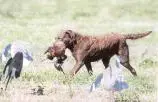
This is a placeholder text
Group text
by The Axe Man on 26 April 2004 - 19:04
Interested to hear from anyone else that has tried different methods other than food on track or drive methods,which I feel leave a lot to be desired & is the dog really tracking the man or the crushed vegetation.I've used SIAB methods the past couple of years with great success.Just wondering as I like to keep at the cutting edge.
Rgds TAM
by HOWDEDO on 26 April 2004 - 23:04
I don't like food on track either. I resort to food only if nothing else works. Even in obedience, I try to use a ball rather than a cookie to get the attention. I do like to use food as a re-inforcer occassionally, especially to teach good "turns" in the track.
by maxislooking on 30 April 2004 - 11:04
It is funny that competitive tracking trains only for a portion of the scent picture. For the real stuff, working dogs use the whole scent picture to follow a track. In fact there is linguistic divide in how we communicate, the trailing versus tracking argument. Competitive tracking trains the dog to look for mostly the vegetative scent. The high levels of competition make the dog distinguish between individuals, using human scent.
We train by using behavior modification in an arena of play. We start puppies doing what is called a "run away." The owner of the puppy runs away and the puppy runs after him. It progresses until the owner is running away out of sight, the drive has been built for the dog to want to find master. He uses his nose to solve the mystery. Puppy run-a-ways will be designed for the puppy to run uphill just to get a wisp of ground scent. Gradually the ritual is transferred to strangers. My dog and I just did a trail that was 24 hours old, two miles long over difficult terrain, crossing two roads, where the dog determine the direction of the trail, without a scent article nor a victim at the end. This cannot be done if you concentrate on just ground disturbance. It takes a partnership to communicate back and forth, interpreting the dog and how it is reacting to scent.
That is how I get the young dog interested in the ground it is not through food rewards. Aged 24 hours at 13 months old, not bad huh?
by HOWDEDO on 30 April 2004 - 19:04
I am amazed!! A 13 month old doing such a long track!!! My dogs were never able to concentrate for that long at this age.
by The Axe Man on 03 May 2004 - 09:05
Maxislooking
Great stuff this is what I'm looking for,someone else who actually trains themselves.I have been trying to access this site again for days, but couldn't get on.I've had enough of this & will not be posting until a few more people there train themselves.(untlike VHK I will not take my ball & run away)
If you wish to email me
stazsi@hotmail.com.
Rgds The Axe Man
by Gertrude Besserwisser on 15 March 2006 - 21:03
The best discussion I have ever read on this subject can be found in the book K9 Professional Tracking by Gerritsen & Haak. It is a great book and they have had incredible success with their method teaching not only competitors, but Austrian avalanche teams, several national police organizations etc. Although the scientific discussion is thorough--especially on why food tracking will create problems--they do not provide, in my opinion, enought detail on the mechanics of teaching their method.
As for tracking the scent of a man, the Scent in a Bottle method pioneered by the Seattle Detective department, Canine Division, is extremely useful and from a theoretical standpoint makes a lot of sense. And, it is quite easy to use.
by Kandi on 15 March 2006 - 23:03
I have a dog here, his food drive is just not high enough to provide the intensity desired on track. So we use the ball. I bury it with a bulb planter and it can be anywhere, at the scent pad, under an article, in the middle of the leg, at a corner, sometimes there's one, sometimes there's 5, sometimes there are none. The only difficult way with this approach is balancing the drive level. Usually I will do a good number of tracks with no ball until I see his drive begin to diminish, then I do one track with, and his head is where I want it for a trial. The balance is difficult and it takes a good feel for your dog. But this is what works for this dog, as I need his drive high enough to accept the corrections without it turning into an argument. :)
Contact information Disclaimer Privacy Statement Copyright Information Terms of Service Cookie policy ↑ Back to top




